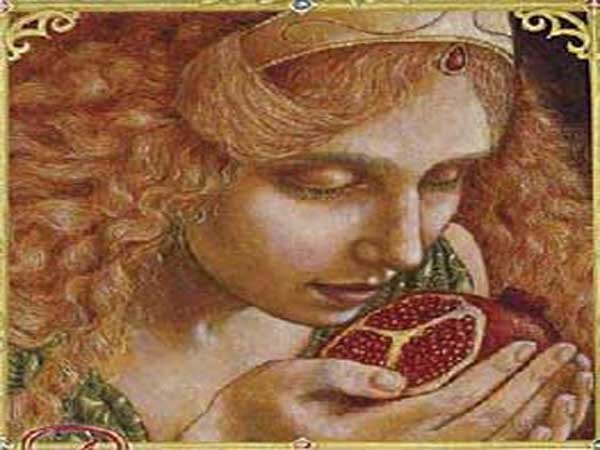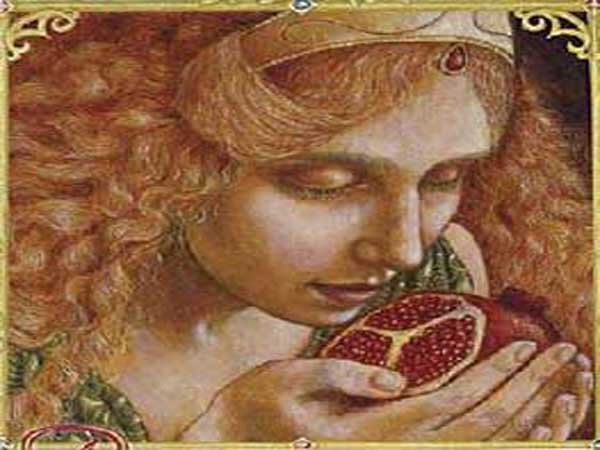Demeter and Persephone - Ceres and Libera
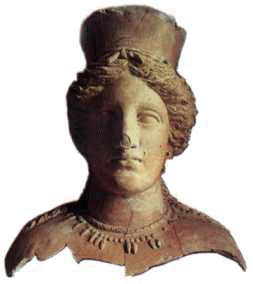
Il Places of the Myth of Demeter - Ceres were - included in the Register of the Region of Sicily LIM (Places of gods and minor divinities)
Places reported on the IWB:
- Rock Sanctuary (Agrigento)
- Rocca of Cerere (Enna)
- Trapani promontory
- Top of the Etna Volcano (province of Catania)
The following is an excerpt
The following is excerpted from: Cults, Myths and Legends of Ancient Sicily (Author: Ignazio Caloggero - ISBN: 9788894321913)
Demeter and Persephone - Ceres and Libera
The origins of the myth
The very name of Demeter can be linked to that of "Mother Goddess" or "Terra Madre”As Diodorus Siculus implies (lib. III.62). Demeter is the deity of the cultivated land, protector of fields and agriculture and is known by the Romans with the name of Ceres.
While absorbing the characteristics of the goddess Gaia (the earth conceived as a universal element), Demeter is distinguished from the latter because, in it, the mythical aspects are intertwined with the religious ones. His legends spread mainly in those areas of the Mediterranean where wheat grows, in particular in Sicily and Greece (plains of Eleusis).
The legend of Demeter is closely linked to that of Persephone, considered her daughter and also known by the names of Core, Libera and Proserpina.
Demeter is represented as a very beautiful goddess, with thick blond hair like the ears of ripe wheat, sitting with a torch or a snake in her hands and her favorite victim is the pig, a symbol of fertility.
Daughter of Cronus and Rhea, she had, from a relationship with her brother Zeus (Jupiter), a daughter to whom she gave the name of Persephone. Pluto, the god of the dead, fell in love with this girl, who, having obtained the consent of Zeus, kidnapped her while she was gathering flowers in the countryside of Enna [1]. Persephone only had time to let out a cry that was heard by her mother, but to no avail, since, rushed to help her daughter, she could not find her because Pluto had already carried her underground, into the kingdom of the dead. After the kidnapping of her daughter, Demeter took hold of a torch lit with the flames of the Etna volcano and searched continuously for nine days and nine nights, but could not find it. During the search, she arrived in Eleusis, in central Greece, where she was welcomed by Triptolemus' parents, who offered her wine which the goddess refused. However, he did prepare a potion called Ciceon, made of flour, water and mint and which will be used as a potion for initiation into the Eleusinian mysteries. Demeter, grateful for the hospitality received, taught Triptolemus the art of cultivating the land and sent him around the world to spread the cultivation of wheat. On the tenth day, the God Helios (the sun) revealed the truth to her and Demeter, irritated with Zeus for having been an accomplice of Pluto, refused to go back to Olympus, until her daughter was returned to her. Missing from Olympus, Demeter no longer fulfilled her functions as protector of the fields and the earth became more and more sterile, so Zeus, who was the guarantor of the harmony of the universe, asked Pluto to return his daughter. Unfortunately this was no longer possible since Persephone, during her stay in the kingdom of the dead, had broken the rule that imposed fasting on her; pushed by Pluto, she had, in fact, eaten a pomegranate grain, thus binding herself definitively to him. However, an agreement was reached, Persephone, for two thirds of the year she would have lived underground with Pluto and for a third in Olympus with her mother. Here, therefore, that every year, in spring, Persephone escapes from the underground to return there in the autumn.
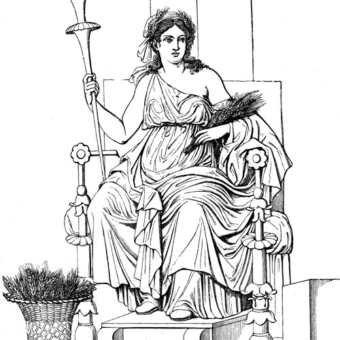
The relationship between Persephone's exit from the subsoil and the sprouts of wheat that come out of the earth in spring and her return to hell is all too clear, which corresponds instead, with the sowing period in which the seeds of wheat are planted underground, consecrating the start of the winter season.
There are many legends that are linked to the myth of Demeter: in some cases she is seen as the creator of the mill, in others she is linked to the cultivation of legumes or fruits such as figs.
Another legend, linked to Demeter's love with Poseidon, tells that to escape the latter, the goddess assumed the appearance of a mare, but the attempt was unsuccessful and Poseidon mounted her. From this union were born a horse named Arione and a daughter known only by the name of "The mistress".
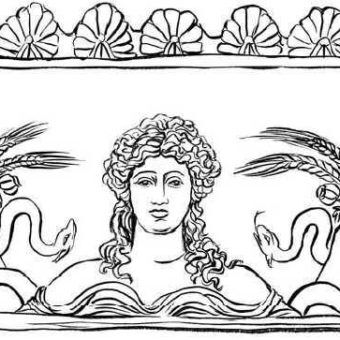
The myth in Sicily
In Sicily it is probable that the cult of a divinity protecting crops existed even before the Greek colonization and that only later, as it happened for most of the divinities that represented aspects of nature, was Hellenized and replaced with that of Demeter, goddess belonging to the caste of the Olympic gods. Enna was probably the place where the cult of Demeter spread the most, although it is widely believed that in this city this cult was superimposed on a pre-existing indigenous cult [2].
In the past it was also formulated the hypothesis that the Sicilian Demeter would have been the wife of Sicano, king of the Sicani, and that she would have taught the Sicilians to cultivate the land [3].
Demeter and Persephone are the central divinities of the Eleusinian mysteries, their cult originating in Eleusis. The cult linked to the mysteries of Eleusis was not originally of a mysteriosophical type, in fact, in the initial phase, it had the typical appearance of a predominantly agrarian religion and was located in the plains of Eleusis, in Greece, where a grandiose temple dedicated to Demeter was built. and Persephone. Only later did the cult take on a mysteriosophical character, became the religion of salvation and spread to the rest of Greece and the Mediterranean. Every year in Eleusis, Greece, the festivities related to the Eleusinian mysteries were celebrated, they lasted nine days and were called "the great mysteries" to distinguish them from the "little mysteries" that lasted three days and were celebrated about six months earlier [4] . The latter served to prepare and purify before the great mysteries. During the celebration of the great mysteries the initiation of the adepts took place and a particular significance assumed the magical-agrarian wedding rite which recalled the union that took place between Demeter and Zeus and which was based on a very ancient rite, common to primitive peoples of character agrarian, in which a suitably chosen couple publicly engaged in sexual intercourse to promote the fertility of the earth; in this case Demeter (the mother earth) was fertilized by Zeus (the lord of the sky) and the sky with its rains made the earth fertile. In the Eleusinian rites, the divine couple was represented by the high priest (the Hierophant) and a priestess. The Hierophant went away with the priestess, the torches went out and those present remained in religious waiting until, after the wedding ceremony (whether symbolic or real), the lights were turned on again and the faithful celebrated the event.
The rites of the Eleusinian mysteries continued for a long time even after the arrival of Christianity. The sanctuary of Eleusis, center of the cult, was destroyed by the emperor Theodosius in 394.
There were many feasts dedicated to Demeter. The holidays finger millet they took place in Athens and had a competitive character, with gymnastic, equestrian and musical competitions [5]; another party called Proherosia, the plowing festival, took place mainly in Athens where, to prepare the soil for sowing, the first fruits of cereals were sacrificed to the goddess.
Throughout the Hellenic world, and therefore also in Sicily, the Thesmophoria which took place during the plowing period and included various ceremonies. During one of these, putrefied pork, which had been stored in the warehouses of the sanctuary of Demeter, was mixed with the grain of the sowing as an omen for a harvest. Another ceremony, in which only married women could participate, lasted three days. On the first day a procession of women brought paste in the shape of genitals, a symbol of fecundity, to the sanctuary of Demeter and Proserpina; the second day was dedicated to fasting, while during the third day dances and sacrifices were performed in honor of the goddesses. Other festivals in honor of Demeter, mentioned by the historian Di Blasi [6], were divided into private and public. In the private ones, the head of the family, towards the beginning of spring, chose an animal to sacrifice, generally a pig (on whose neck he put an oak crown), and then, with the animal and the whole family who followed him, carrying oak branches, he went into his own field. The procession thus formed made three laps around the harvest singing hymns to Demeter to whom, after the ceremony, must and milk were offered.
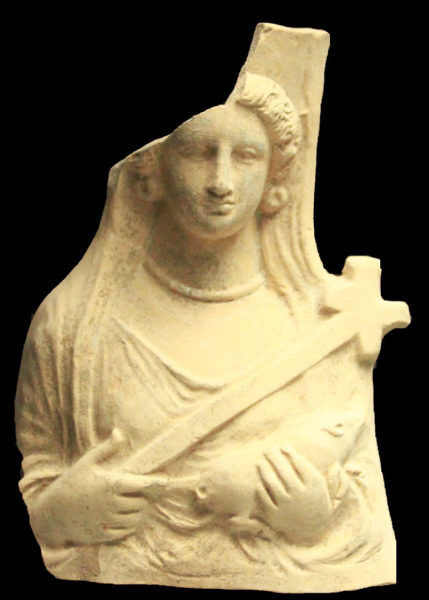
Bust of Demeter with cross torch and pig. From Herakleia, Sanctuary of Demeter, IV-III century BC Preserved at the National Archaeological Museum of Policoro (Author Photo)
The party just described has similarities with another party: the Ambarvalie, which was always celebrated in Rome in honor of Ceres. During the celebrations, which took place towards the end of May, a pig, a sheep and a bull were carried in procession three times around the city before being sacrificed. Traces of the fact that the pig was sacrificed can be found in finds of votive materials, such as those found in Terravecchia (near Grammichele, in the province of Catania) and now preserved in the Regional Museum of Syracuse and those found on the beach north of the ancient inhabited by Eloro, where the votive statuettes represent Demeter with the torch and the pig [8].
The public ceremonies consisted of a procession, made after the harvest period, in which the population participated. The procession was opened by the priests and the most influential personalities of society, followed by the rest of the population. The procession was closed by a group of girls dressed in white who carried the statue of the Goddess whose head was crowned with spikes and not flowers out of respect for the divinity who had lost her daughter while she was picking flowers. The statue carried a basket full of wheat hanging from his right arm and a hoe in his hand, while on his left hand he held a scythe. The procession went around the fields singing songs and then returned to the sanctuary, where gifts were offered to the Goddess. The songs were, according to Diodorus, (lib. V.4) vulgar, just as vulgar and obscene were the words that were exchanged during the celebrations; in fact it was believed that such vulgarity mitigated Demeter's pain for the loss of her daughter.
Another public festival was inspired by the legend in which it is said that Demeter turned the night on Mount Etna with a lighted torch in search of her daughter Persephone. Those who celebrated this rite, therefore, went out of the town at night and went to Mount Etna with a lighted torch in their hand calling out to Persephone. At the end, private sacrifices consisting of the first fruits of the fields were offered and the feast ended with a lunch with relatives.
Cult of Demeter and the places of Sicily
Enna
A sanctuary dedicated to Demeter probably existed ad Enna, just near what is called Rocca di Cerere [9]. It is a large rock north of the Norman castle called Castello di Lombardia and, although there are no visible traces of the sanctuary on the rock, its presence would be confirmed by an inscription found on a boulder that was probably placed at the foot of the statue of Demeter. Cicero speaks extensively of the cult of Ceres in Enna (Verrine II.IV, 106-112): he says that, although there is a temple dedicated to Ceres in Rome, some priests of the Roman people left on pilgrimage for the sanctuary of Ceres in Enna. He also tells that Verre, unable to take possession of the statue of Ceres located in front of the temple dedicated to her because it was too large, stole the statue of Vittoria [10] that the goddess held on her right hand.
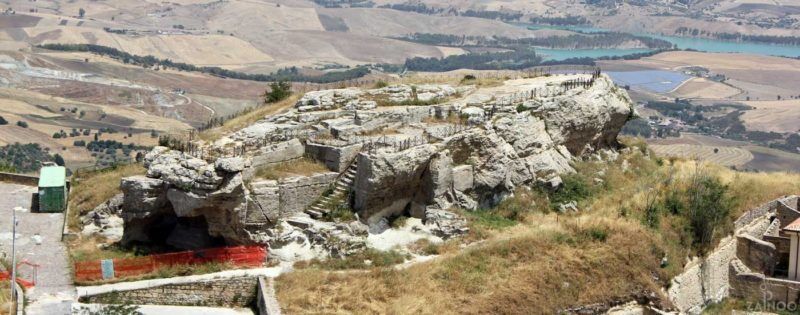
Rocca of Cerere
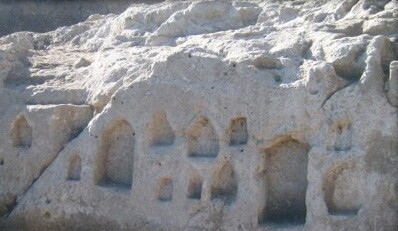
Aedicules near the fortress of Ceres where there was probably an area dedicated to Demeter and Ceres
Most of the coins from Enna were inspired by Demeter; also the slave Euno who, after the first slave revolt in Sicily in 139 BC, called himself King Antiochus, had the figure of Demeter represented on his coins with a wreath of wheat (as B. Pace points out, this element does emerge more the indigenous nature of the cult) [11]. One of these copper coins is now in the British Museum in London.
Catania
Of the cult of Ceres a Catania Cicero speaks (Verrine, II.IV.99). He says that in Catania there was a shrine dedicated to Ceres and that inside this sanctuary there was "a very ancient statue of Ceres, which male people not only did not know in its physical appearance, but whose existence they also did not know". In fact, men were not allowed to enter the sanctuary. The men of Verre, at night and stealthily, took away the statue of Ceres.
Selinunte
A Selinunte on the Gaggera hill, not far from the acropolis, you can visit the sanctuary of Demeter Malophoros. This sanctuary was frequented for a long period, and it is possible to trace the oldest parts to the end of the 12th century. BC [XNUMX].
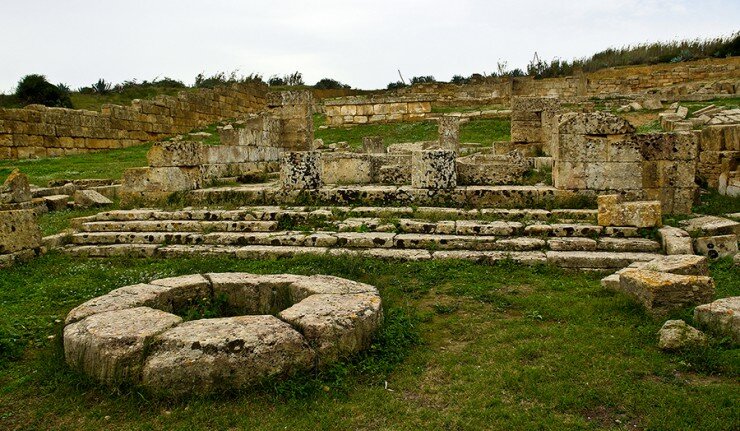
Selinunte
The sanctuary was probably built on the site of an ancient indigenous cult and also frequented in the Punic era, since the cult of Demeter, mentioned in the "Great Table of Selinunte" [13] was later also introduced in Carthage.
Mount Adranone
A small shrine dedicated to Demeter and Persephone has been identified on the Mount Adranone, about 8 km north of Sambuca di Sicilia, where excavations started in 1968 have brought to light the remains of the Sicilian village of Adranon.
Gela
A Gela the cult of Demeter was particularly flourishing, in fact, several sanctuaries have been identified, especially in the extra-urban area. The main of these is located on the right bank of the Gela river, on the Bitalemi hill [14], and can be traced back to the beginning of the colonization of Gela.
An example of the syncretic phenomenon that links the cult of the Madonna to that of Demeter comes from the extra-urban sanctuary located on the Bitalemi hill in Gela. It seems, in fact, that the cult of Demeter survived even after the destruction of the city, which took place in 405 BC, until the Christian era and it is assumed that the cult of veneration of the Madonna of Bethlehem, to which a small church was dedicated at the top of the hill of Bitalemi (the name of Bitalemi itself derives from that of Bethlehem), has replaced that of Demeter.
Agrigento
In Agrigento, on the eastern slopes of the cliff of Athena, the Doric temple of Demeter is still visible, dating back to 470 BC which is partially incorporated into the medieval church of S. Biagio. From the terrace of the church of San Biagio, through a staircase carved into the rock, you reach the sanctuary below dedicated to Demeter and Persephone. The place is also known by the name of the rock sanctuary of San Biagio. The Sanctuary is completely excavated inside the hill.
Also in Agrigento, in the center of the valley of the temples, there was a sanctuary of Demeter and Persephone; the site was later occupied by the church of S. Nicola in whose place there is now the National Museum of Agrigento. The sanctuary, which can be traced back to the VI-V century. B.C[1], is now buried by the museum building and is therefore no longer visible; from it come votive and ceramic materials preserved, in part, in the rooms of the National Museum.
[1]F. Coarelli and M. Torelli: Sicily "Archaeological Guides Laterza" p.151.
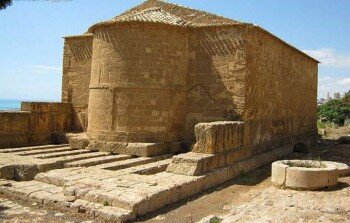
Remains of the Temio di Demeter and church of San Biagio
Piazza Armerina
A sanctuary of Ceres must have been in the area of Piazza Armerina as indicated in one of the mosaics of the Romanesque Villa in Piazza Armerina [16].
Morgantina
Two small shrines dedicated to Demeter and Persephone have been found in Morgantina[17] in the province of Enna. The ancient center, founded, according to the historian Strabone, by the Morgetis.
Camarina
The cult was also to be alive in Camarina [18], where votive statuettes of Demeter were found.
SIRACUSA
Also to SIRACUSA the cult of Demeter and Persephone was widespread. The belief has it, in fact, that Pluto, after having kidnapped Persephone near Enna, then sank underground near Syracuse at the source of the Ciane, where, according to legend, Pluto turned the nymph Ciane into a spring who had dared to oppose the kidnapping.
Also in Syracuse there were several sanctuaries dedicated to the cult of Demeter and Persephone, and two superb temples Cicero also speaks (lib. II. IV.119). Traces of some of these temples have remained to this day. One of these would have been located in Piazza della Vittoria [19], probably dates back to the fifth century. BC, is dug into the rock and there are clear traces of frequentation up to the second century. B.C. Another was located in Fusco and it was wanted to identify it with the one mentioned by Diodorus Siculus (lib XIV.63) and destroyed by the Carthaginian Imilcone in 396 BC

Syracuse Piazza della Vittoria: remains of the sanctuary of Demeter and Kore
A sanctuary, according to Diodorus Siculus, was built in Syracuse by Gelone around 480 BC, and yet another was located in the Etnea area [20].
Eloro
Another place where traces of the cult of Demeter have been found is Eloro [21] where the remains of a sanctuary were found in which, later, a Byzantine basilica was built with the materials of the pre-existing sanctuary [22].
adrano
Another sanctuary was probably to be located at adrano, a locality about 28 km north-west of Catania, near the former Monastery of S. Maria e Gesù, where at the beginning of the century, in the internal courtyard, some votive terracottas depicting Demeter with the torch and the classic pig were found . Some of these finds are now kept in the Syracuse museum.
Comiso
A Comiso numerous clues would confirm the cult of Demeter [23]
Aeolian
Even in the islands Aeolian there is a trace of this cult. In fact, a 24th century sanctuary was found near the necropolis in Lipari. BC dedicated to Demeter and Persephone [XNUMX].
Etna
The natural element that best represents Demeter is wheat, this, together with the volcano, are the two elements that characterize ancient Sicily. It is no coincidence, in fact, that in ancient mythology it is said that Demeter and Hephaestus (the god of volcanoes) had to contend for possession of the island. On that occasion the nymph Etna (who later gave the name to the same volcano) intervened as a mediator.
That the cult of Demeter, together with that of Persephone, was one of the most widespread in Sicily, is demonstrated not only by the enormous quantity of archaeological finds but also by the fact that on what is considered the symbol par excellence of Sicily, the Trinacria, there are elements referable to the cult of Demeter. The Trinacria, in fact, consists of the face of the Medusa placed in the center of three legs that refer to the three promontories of the island (Lillibeo, Pachino, Peloro). The face of the medusa is surrounded by four snakes and two wings and, at times, also by ears of wheat that recall the cult of Demeter.
Myth and religious syncretism
Traces of the cult of Demeter are identifiable in some religious feasts of the Christian era.
The ancient habit, during the Thesmophoria, of throwing rotten pork in the fields to favor the harvest, was found during the feast of St. George in Ragusa where, together with the saint, two very large loaves were carried in procession which at the end of the festival were chopped and distributed to farmers so that each of them threw their own piece into the sown fields, thus propitiating a good harvest [25].
Something ancient also evoked the feast of the Madonna of Lavina in Cerami, told by Pitrè [26] and celebrated on 7 and 8 September. The procession of the Madonna was followed by devotees who, barefoot, brought as a gift the first fruits of the fields, hares, rabbits and more hanging from a large laurel flag, together with colored handkerchiefs and images of the Madonna. They were called"Graduates", precisely because of the laurel branch they used to bring gifts to the Madonna. During the night, every family, regardless of their social class, went to church to eat the ritual sausage. On the occasion of this festival, the consumption of pork in honor of the Madonna assumed particular importance, as in ancient times for Demeter. This is demonstrated by the fact that the slaughter of pigs was allowed, on an exceptional basis, even though it was still in the hot season, and that, by papal authorization, (requested by the local ecclesiastical authorities), the use of meat was permitted. Friday, in case the party fell on that day.
We said that Enna was the center of the cult of Demeter, goddess of agriculture and protector of the fields, and just not far from this city, in Calascibetta, during the feast of the patron St. Peter, there was a procession until a few decades ago. of the statues of the various saints carried by the peasants who started from the church they belonged to and went up to the church of the patron saint. Each statue was loaded with the products of the earth such as: fruit of all kinds, flowers and basil [27].
In Sicily, traces of the cult of Demeter can be found in the feast of June 13 of St. Anthony of Padua, considered the patron saint of orphans and prisoners and also invoked to find lost objects and against female sterility. Demeter, in fact, favored the fertility of the earth, St. Anthony protects that of the woman and, in the past, the earth was seen precisely as a female element and therefore as the woman herself. In Sicily another link between the two divinities is given by the fact that S. Antonio is also the protector of cereals. Probably still today some farmers will pay attention to the thirteen days that go from 1 to 13 June, during which the messages coming from the fields are observed very carefully to understand what the fate of the wheat will be for the current year [28].
Wandering in the countryside it may happen to see pomegranate trees whose branches are tied with particular herbs, hung with the belief that this favors the fertilization of flowers. Here, then, is another element of contact with the cult of Demeter. It was, in fact, a pomegranate grain that definitively bound Persephone, the daughter of Demeter, to Pluto, the lord of the underworld.
In Ragusa, the bread made on St. Anthony's day is blessed and then shared with friends and relatives. At the moment in which the bread is broken to eat it, it is recited "in triricina di S. Antonio " consisting of 13 Ave Maria, 13 Our Pater and 13 Gloria Pater.
The Myth in the IWB Register of the Sicily Region
The Sicily Region has entered the Myth of Demeter - Ceres in the LIM register (Places of identity and memory) - Places of gods and minor divinities. The places identified in the register are:
- Rock Sanctuary (Agrigento)
- Rocca of Cerere (Enna)
- Trapani promontory
- Top of the Etna Volcano (province of Catania)
The reference of Demeter to the Promontory of Trapani is not clear, according to some it should be attributed to the fact that Trapani, whose Greek name “Drepanon” means sickle, originated precisely from the sickle fallen to Demeter during the search for Persephone. Another myth actually has it that the sickle, at the origin of the city, is the one that fell to Saturn (Cronos) after he had cut off the "phallo" from his father Uranus.
In reality, as we have seen from the card, there are many places that would be interested in worship, in addition to those reported on the IWB we have at least the following:
- Catania,
- Selinunte,
- freeze,
- Piazza Armerina,
- Mount Adranone,
- Morgantine,
- Syracuse,
- they,
- Adrano,
- Aeolian
- Camarina
- Comiso (probably)
[2] Biagio Pace: Art and Civilization of Ancient Sicily vol.III. page 470.
[3] Giovanni E. Di-Blasi: History of the Kingdom of Sicily p.58
[4] Nicola Turchi: The religions of the mysteries in the ancient world. p.55
[5] Nicola Turchi: The religions of the mysteries in the ancient world. p.57
[6] Encyclopedia of universal mythology by A.Morelli.p. 531.
[7] Giovanni E. Di-Blasi: History of the kingdom of Sicily. vol. I p..58
[8] Sabatino Moscati: The Mediterranean civilization p.109.
[9] F. Coarelli and M. Torelli: Sicily p.171.
[10] Victoria, to be identified with the Greek Nice, is the personification of victory and is depicted as a young winged woman. Later, this representation influenced the classical iconography of Christian angels.
[11] Biagio Pace: Art and Civilization of Ancient Sicily vol.III. page 471.
[12] F. Coarelli and M. Torelli: Sicily p.100.
[13] The "great table of Selinunte" is a table in which after a victory (the battle of Imera in 480 BC against the Carthaginians), some divinities are thanked: Zeus, Phobos, Heracles, Apollo, Poseidon, the Tindarids, Athena , Demeter, Pasicrateia. The Tablet was placed in the temple of Apollo of Selinunte and is currently located in the National Archaeological Museum of Palermo.
[14] Vincenzo Tusa and Ernesto De Miro: Western Sicily p.215.
[15] F. Coarelli and M. Torelli: Sicily “Archaeological Guides Laterza” p.151.
[16] F. Coarelli and M. Torelli: Sicily “Archaeological Guides Laterza” p.185.
[17] The remains of ancient Morgantina are found in central Sicily, about 6 km from Aidone in the province of Enna,
[18] The site of the ancient city of Camarina has been identified on the Ragusa coast.
[19] F. Coarelli and M. Torelli: Sicily “Laterza Archaeological Guides” p-247.
[20] Diodorus Siculus XI.26
[21] Eloro, formerly Heloros stood near Noto Marina just north of the mouth of the River Tellaro, also formerly called Heloros.
[22] F. Coarelli and M. Torelli: Sicily “Archaeological Guides Laterza” p.287.
[23] Biagio Pace: Art and Civilization of Ancient Sicily vol.III. page 582.
[24] F. Coarelli and M. Torelli: Sicily “Archaeological Guides Laterza” p.374.
[25] Giuseppe Pitre: Patronal Festivities in Sicily p.324.
[26] Giuseppe Pitre: Patronal Festivities in Sicily p.244.
[27] Giuseppe Pitre: Patronal Festivals in Sicily p.538
[28] Giuseppe Pitre: Sicilian folk shows and festivals. p.271.
Card insertion: Ignazio Caloggero
Photo: web
Information contributions: Ignazio Caloggero, Region of Sicily
